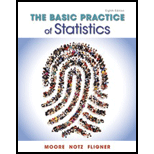
Concept explainers
(a)
To state: The hypotheses in terms of the population means for men
(a)
Answer to Problem 21.25E
The null hypothesis is
The alternative hypothesis is
Explanation of Solution
Given info:
The data shows the average number of words spoken per day by men and women.
Explanation:
State the test hypotheses.
Null hypothesis:
Alternative hypothesis:
(b)
To find: The two-sample t statistic.
(b)
Answer to Problem 21.25E
The two-sample t statistic for study 1 is –0.248.
The two-sample t statistic for study 2 is 1.507.
Explanation of Solution
Calculation:
From the given information,
Test statistic for study 1:
The value of t statistic is obtained below:
Thus, the two-sample t statistic for study 1 is –0.248.
From the given information,
Test statistic for study 2:
The value of t statistic is obtained below:
Thus, the two-sample t statistic for study 2 is 1.507.
(c)
To find: The degrees of freedom by using Option 2.
(c)
Answer to Problem 21.25E
The degree of freedom for study 1 is 55.
The degree of freedom for study 2 is 19.
Explanation of Solution
Calculation:
For study 1,
The degrees of freedom for the two-sample t procedures with the conservative Option 2 is,
Thus, the degrees of freedom for study 1 is 55.
For study 2,
The degrees of freedom for the two-sample t procedures with the conservative Option 2 is,
Thus, the degrees of freedom for study 2 is 19.
(d)
To find: The P-value.
(d)
Answer to Problem 21.25E
For study 1, the P-value for one-sided test is
For study 2, the P-value for one-sided test is
Explanation of Solution
Calculation:
For study 1,
The degree of freedom for study 1 is 55, which is not in the degrees of freedom column.
Thus, choose the next row with degrees of freedom smaller than 55. That is, the next row with smaller degrees of freedom would be 50.
From the table of “t Distribution critical values”, the t-value
For study 2,
The degree of freedom for study 2 is 19.
From the table of “t Distribution critical values”, the t-value 1.507 is located between 1.328 and 1.729 with corresponding level 0.10 and 0.05. Hence, the P-value for one-sided test is
(e)
To identify: The conclusion.
(e)
Answer to Problem 21.25E
For study 1,
The conclusion is that, there is no evidence that the women talk more than men.
For study 2,
For study 2,
The conclusion is that, there is evidence that the women talk more than men.
Explanation of Solution
Conclusion:
Study 1:
Here, the P-value is very high.
Therefore, by the rejection rule, it can be concluded that there is no evidence to reject
Study 2:
Here, the P-value is
Therefore, by the rejection rule, it can be concluded that there is evidence to reject
Want to see more full solutions like this?
Chapter 21 Solutions
The Basic Practice of Statistics
 MATLAB: An Introduction with ApplicationsStatisticsISBN:9781119256830Author:Amos GilatPublisher:John Wiley & Sons Inc
MATLAB: An Introduction with ApplicationsStatisticsISBN:9781119256830Author:Amos GilatPublisher:John Wiley & Sons Inc Probability and Statistics for Engineering and th...StatisticsISBN:9781305251809Author:Jay L. DevorePublisher:Cengage Learning
Probability and Statistics for Engineering and th...StatisticsISBN:9781305251809Author:Jay L. DevorePublisher:Cengage Learning Statistics for The Behavioral Sciences (MindTap C...StatisticsISBN:9781305504912Author:Frederick J Gravetter, Larry B. WallnauPublisher:Cengage Learning
Statistics for The Behavioral Sciences (MindTap C...StatisticsISBN:9781305504912Author:Frederick J Gravetter, Larry B. WallnauPublisher:Cengage Learning Elementary Statistics: Picturing the World (7th E...StatisticsISBN:9780134683416Author:Ron Larson, Betsy FarberPublisher:PEARSON
Elementary Statistics: Picturing the World (7th E...StatisticsISBN:9780134683416Author:Ron Larson, Betsy FarberPublisher:PEARSON The Basic Practice of StatisticsStatisticsISBN:9781319042578Author:David S. Moore, William I. Notz, Michael A. FlignerPublisher:W. H. Freeman
The Basic Practice of StatisticsStatisticsISBN:9781319042578Author:David S. Moore, William I. Notz, Michael A. FlignerPublisher:W. H. Freeman Introduction to the Practice of StatisticsStatisticsISBN:9781319013387Author:David S. Moore, George P. McCabe, Bruce A. CraigPublisher:W. H. Freeman
Introduction to the Practice of StatisticsStatisticsISBN:9781319013387Author:David S. Moore, George P. McCabe, Bruce A. CraigPublisher:W. H. Freeman





